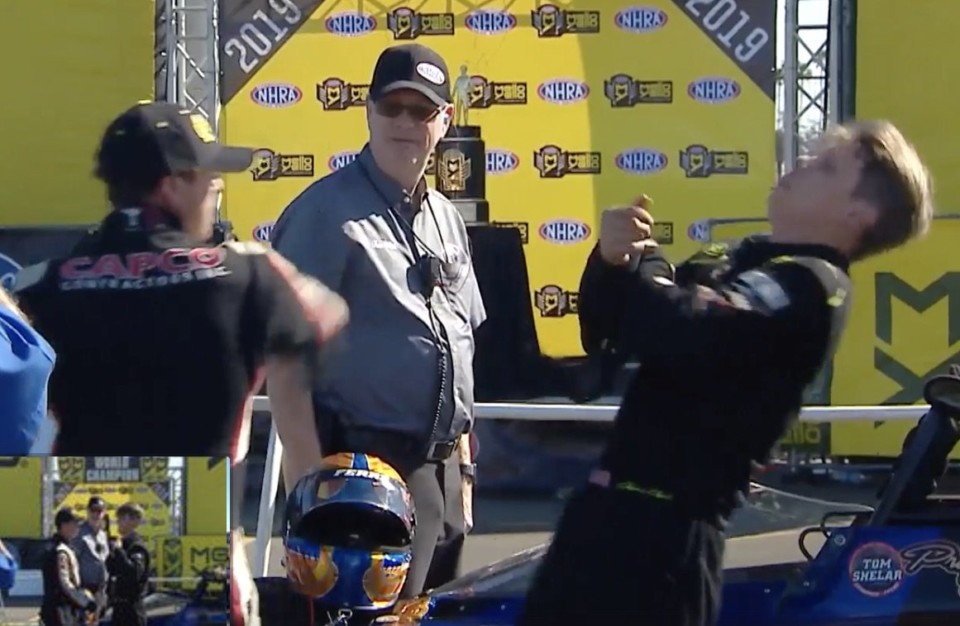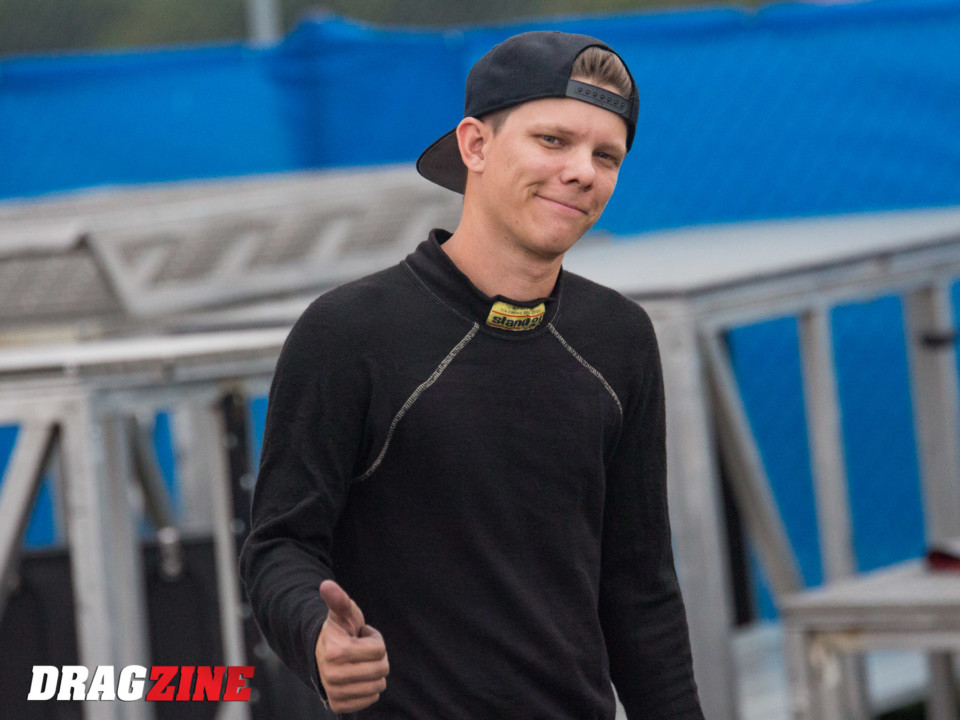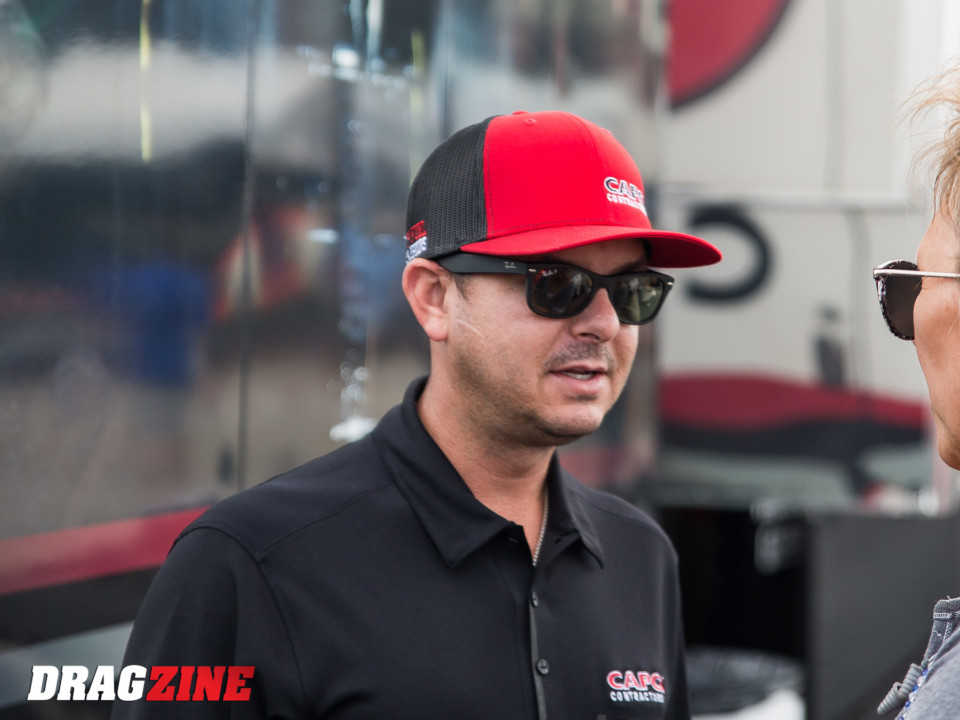Despite all of the incredible storylines tailor-made by the NHRA’s Countdown to the Championship playoff-style format, the buzz at the season-ending Auto Club Finals at Pomona, California was hijacked Sunday by an aggressive palm to the face of Top Fuel privateer Cameron Ferre by championship leader Steve Torrence. The heated incident occurred following the duo’s opening round matchup, when Ferre, the No. 16 qualifier, rolled his dragster in deep in an effort to gain an advantage over the clearly superior Capco dragster of Torrence. Its didn’t work, but nevertheless, Torrence was miffed.
Torrence took issue with Ferre’s gamesmanship and confronted him in the shutdown area — their exchange quickly turned from congratulatory to tempered as Torrence, unprovoked, forcefully shoved Ferre by the face, igniting a very brief exchange that appeared headed to full-on fisticuffs if not for a member of Torrence’s crew stepping between the two and separating them.
Let’s be clear on a couple of facts.
First, Steve Torrence was in the wrong here. According to drag racing historian Bret Kepner, deep staging has been a feature of drag racing christmas trees/timing systems since somewhere around 1967 or ’68, and drag racers have been employing the tactic for as long as it’s been at their disposal. John Force, the most decorated professional drag racer of all-time, has been known to roll in deep on occasion to game his opponents, and has not once been chastised for it. That Torrence would take issue with Ferre’s tactic suggests a lack of understanding of how drag racing works, a sense of entitlement in a highly-important race for the championship, or both.
Second, this was not a case of a silver-haired veteran picking on a young, cocky kid that’s in over his head. Steve Torrence is 36, and the baby-faced Ferre is 34. While the two come from distinctly different backgrounds and levels of affluence, each has a wealth of experience in business and in drag racing and has — or should have — rightly earned the complete respect of their peers on and off the racetrack.
#NHRAFinalsThings are getting heated at the @AAA Automobile Club of Southern California #NHRAFinals! Watch the action on FS1 at 4p ET! 👀
Posted by NHRA on Sunday, November 17, 2019
Some fans, in response, sided with Torrence and suggested Ferre was at fault and should have simply “gotten out of the way.” But to think that team owner Terry Haddock is going to haul his dragster to California from Texas, absorb the outrageous cost of parts and nitromethane to the tune of $34 per gallon, and that the working-class Ferre is going to scrounge up the money to help out, and then intentionally yield to a championship contender, is both blissfully ignorant and preposterous.
The majority, however, citing the NHRA’s written code of conduct word-for-word, called for Torrence’s disqualification — a move that would have been not only unprecedented, but as the final race result will reflect, would have given the championship to Doug Kalitta with air to spare. While a disqualification may have done little harm in March or even July, such a decision with the championship on the line is no small matter.
It also, in our opinion, would have sent the wrong message to racers, to the fans, and to corporate America.
His face still flooded from the dust-up with Torrence, Ferre commented to FS1 reporter Amanda Busick, “We’re out here to try to better the sport, and that’s not bettering the sport.”
But with all due respect to Ferre, who is a good friend to all of us at Dragzine and didn’t deserve to be shoved, it did better the sport.
Remember the classic scene of Cale Yarborough and Donnie Allison brawling at the 1979 Daytona 500 after crashing one another out while trading the lead on the final lap? That one incident has long been credited for putting NASCAR on the map, and it’s that kind of emotion and unpredictability that motorsports — and particularly drag racing — have been sorely missing for a long, long time. And the fans — even those who decried Torrence’s actions on Sunday — know it.
It’s those very fans who paint NHRA drag racing as a boring product, urging drivers to show more emotion and for the NHRA to not only allow it, but perhaps even encourage it. But then, when it happens, they don’t like it and demand action from the sanctioning body. Either you want raw emotion, or you want hugs and handshakes — you can’t have it both ways.
If you were on any social media platform on Sunday afternoon, you couldn’t possibly do so without seeing mention of the Torrence/Ferre dust-up, and those kinds of viral and controversial storylines are precisely what NHRA drag racing needs to ignite greater interest in the sport. Ferre, if you haven’t seen the video clips, was showered with applause from the fans in Pomona as he made his way back up the return road. Torrence, meanwhile, was boo’ed by the Pomona faithful. Regardless of which side you’re on, a good-buy, bad-guy rivalry was created, and as a rising tide lifts all boats, the NHRA and its teams are the benefactor.
Thusly, disqualifying Torrence — even if he weren’t in the championship fight at all — was not in the best interests of anyone. For one, it would have completely spoiled the buzz gained by the incident; but it would also ensure that other drivers would refrain from showing such emotion in the future, while making the bold statement that the NHRA is not going to allow the very temperament that its fans and would-be fans crave. In essence, they’d be proclaiming, “we’re lame.”
Hugs and handshakes don’t sell tickets, nor do they put drag racing on the nightly news or the Monday morning paper.
Dragzine reached out to the NHRA for comment. Senior Director of Public Relations and Communications Jessica Hatcher did not directly address the organizations’ policy on conduct as it related to the incident, sharing only that, “The NHRA is disappointed in the situation that occurred between Steve Torrence and Cameron Ferre after the first round of Top Fuel competition at the Auto Club NHRA Finals. We are evaluating the matter and any potential penalties will be assessed after a thorough review.”
Bear in mind the unprecedented nature of disqualifying a competitor before the event is complete that the NHRA would have to weigh in this scenario. In other forms of motorsport, such a call only occurs if a competitor is driving recklessly or is a hazard on the racetrack, and more often than not, involves an off-track altercation taking place after the checkered flag has waved, thus rarely directly affecting the outcome of the race. Drag racing, on the other hand, affords the opportunity for a driver to be disqualified for their off-track actions as many as seven times before the race is completed. A disqualification or forfeiture of points at the last race of the season is a discretionary call we — and probably no other motorsports organization — would want to have to make.
The NHRA rulebook states: Participants at events are expected, at all times, to conduct themselves in a professional manner consistent with good sportsmanship and NHRA’s role as a family-oriented sports organization with events suitable for attendance by all and, as to those events are televised, suitable for unrestricted viewing by the public.
It goes on to include: Any participant who, in the sole and absolute judgement of the NHRA (1) verbally or physically threatens another person; (3) engages in unsportsmanlike conduct; (4) engages in conduct detrimental to the sport of racing; (5) otherwise creates a condition or circumstance that is unsafe, unfair, or out of order, shall have violated this rule regarding participant conduct.
It should read: (1) This is a highly competitive sport, and you’re not always going to like one another or one another’s actions. Be real, be raw, don’t let it cross the line into assault.
Was Steve Torrence justified in getting upset over a legal maneuver and provoking a fight? Absolutely not. But was this altercation that he initiated and the fiery interviews by the two drivers good for drag racing? You’re damn right it was, and that it overshadowed one of the most incredible and memorable days of drag racing in years proves it so.






